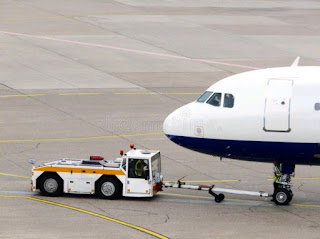"Such a big plane and it cannot reverse by itself! But why can't they go backwards on their own like cars do!...."
....exclaimed my kid earlier this morning. We were at the airport & I was showing her a "tug" (the tractor like automobile that is attached to the front of an airplane to push it backwards from its parked position).
Although many aircrafts are capable of moving themselves backwards on the ground using reverse thrust (a procedure referred to as a powerback), the resulting jet blast or prop wash would cause increased noise, damage to the terminal building or equipment, and hurt airport staff due to high-speed debris. This debris would also be sucked into the engine, as it is in normal use, and cause excessive wear - a major cause of wear on aircraft engines is during ground use. A pushback is therefore the preferred method when ground-handling aircraft. Since the pilots cannot see what is behind the aircraft, steering is done by the pushback tractor driver and not by the pilots. [Source: Wikipedia]
However, I had to keep it simple for her so I simply said "The plane is too heavy to be able to go back on its own. Cars are lighter so they can, however planes have big engines that only push it ahead and cannot push them backwards".
Got me thinking about how the same applies to people and organizations. Once you grow older/bigger, it increasingly becomes difficult to have the ability to go backwards or take steps in the reverse direction. Unknown to us, the reverse movement/pushback might be needed as the first step towards attaining a position from which we can then thrust ahead and attempt to take flight. It often takes a small yet powerful "tug" like an unexpected person/event/incident to push us back, thereby getting us back on track to give us a chance to fly once again.
Click here to read this on Linkedin

No comments:
Post a Comment